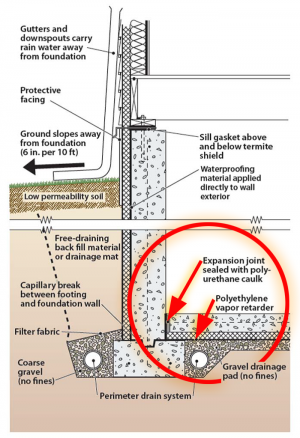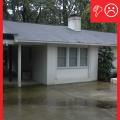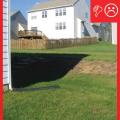Scope
To direct storm water runoff away from the foundation:
- Slope permeable surfaces away from the house at least 0.5 inch per foot for 10 feet.
- Tamp (mechanically compact) the back-fill to prevent later settling.
- If setbacks limit the space to less than 10 feet, install either swales or drains designed to carry water away from the foundation (ENERGY STAR).
See the Compliance Tab for links to related codes and standards and voluntary federal energy-efficiency program requirements.
Description
Because no waterproofing system is 100% foolproof, the best defense against water intrusion through the foundation is to prevent water from saturating the soil around the foundation. This can be done by constructing the foundation and grading the site so that water drains away from the house on all sides (see Figure 1).

How to Grade the Site
- Grade to build up the site before construction, if needed, to create a slope that will carry water down and away from the foundation on all four sides.
- Excavate, install foundation footings, stem wall, and slab. Install footing drain pipe, waterproofing, and any exterior insulation.
- After construction, back-fill to the foundation walls, grade the slope, cap the top layer of the grade with 2 to 4 inches of silty clay, and mechanically compact the soils to prevent later settling.
The 2009, 2012, and 2015 International Residential Code require impervious surfaces within 10 feet of the building’s foundation to have a slope of 2% away from the foundation. ENERGY STAR Single-Family New Homes requires permeable surfaces sloped ≥ 0.5 inch per foot away from the home for ≥ 10 feet. ENERGY STAR also states:
- Tamping of the back-fill is not required if either: proper drainage can be achieved using non-settling compact soils, as determined by a certified hydrologist, soil scientist, or engineer; OR, the builder has scheduled a site visit to provide in-fill and final grading after settling has occurred (e.g., after the first rainy season).
- If setbacks limit the space on any side of the home to less than 10 feet, or if walls, slopes or other physical barriers prevent the construction of slopes away from the foundation, then install either swales or perimeter drains designed to carry water away from the foundation.
Success
Visually inspect that back-fill has been tamped and permeable surfaces sloped ≥ 0.5 inches per foot away from the home for ≥ 10 feet. Where setbacks limit space to less than 10 feet, see that swales or drains are installed to carry water from the foundation.
Climate
Hurricane and High Wind Locations
In locations prone to heavy winds, follow all local codes regarding site stormwater management. In locations that experience frequent heavy rainfall events, in addition to grading the site, consider these other measures to help address rainwater management and to reduce ponding and erosion on site.
- Consider house designs with hip roofs and overhangs.
- Install gutters, kickout diverters, and downspouts adequately sized to handle large storm events. Direct water to an approved location such as a swale or drywell.
- Construct swales that drain to a French drain or drywell.
- Slope all hard surfaces away from the foundation, including patios, sidewalks, and driveways, or provide drains. Use open brickwork or porous paving as shown in Figure 2 when replacing a driveway or parking lot (FEMA 511 2005). Pervious pavers reduce runoff and allow slow percolation of water into the soil.
- Install rain barrels or cisterns that collect and hold rainwater for lawn and garden watering. This reduces both stormwater runoff and homeowner water bills (FEMA 511 2005).
- Construct rain gardens and plant them with native plants that soak up rainwater and have deep roots to improve filtration (see Figure 1). These gardens incorporate design features that can allow approximately 30% more water to soak into the ground than a conventional patch of lawn (FEMA 511 2005). Rain gardens should be installed more than 10 feet away from the house.
In areas prone to coastal flooding, consider building homes on pier foundations at least one foot above the base flood elevation.
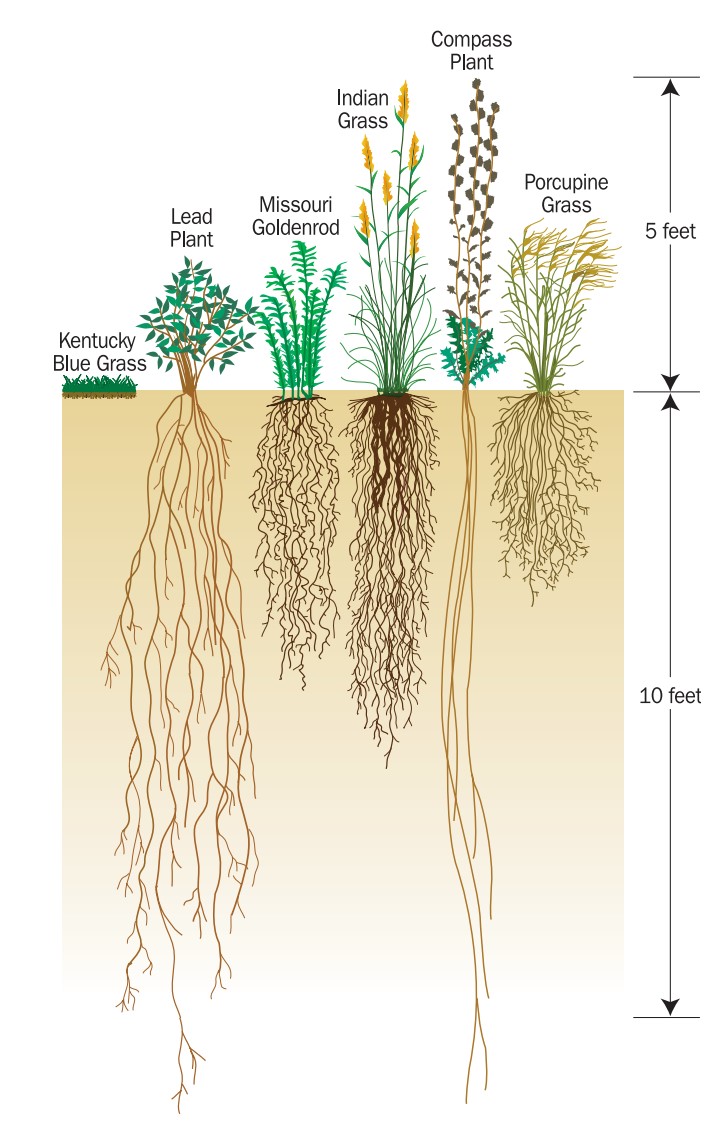
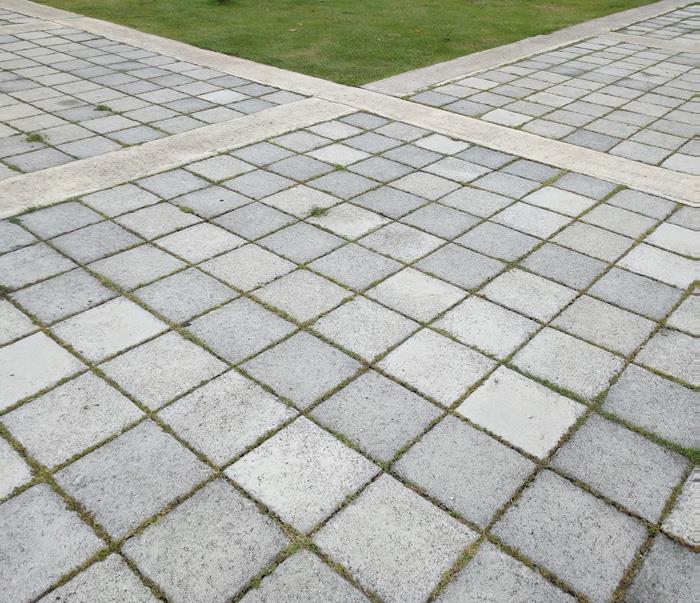
Figure 2. Porous surfaces like pavers allow water to pass through and percolate slowly into the soil. (Source: Enterprise Community Partners 2019& p. 77).
Cold Climates and High Snow Load Areas
Snow melt from the roof can fall to the ground and freeze, creating an ice ridge around the foundation. This ice ridge may direct water from snow melt back to the foundation. Longer overhangs, steeper ground slope, and additional foundation water proofing protection can all help to reduce the likelihood of water leakage and or damage.
Training
Compliance
Retrofit
Once a home has been constructed and concrete driveways and patios are poured, it is a difficult and expensive process to regrade the site should water issues arise due to negative slope on one or more sides of the home. Other options for dealing with water that wants to flow toward the house are to install footing drains if they don’t currently exist and to install damproofing and/or dimpled plastic moisture barrier on the exterior surface of the below-grade walls. Swales or other drainage systems can be constructed as described in the Description tab to carry water away from the home and to a drywell, stormwater sewer, or other drainage location downstream of the home. Drains can be installed at the base of driveways and patios that slope toward the house. Solid-surface driveways, patios, and walkways can be replaced with pervious surfaces such as pavers, gravel, or pebbles, to allow water to drain into the ground rather than flowing toward the house. Sometimes a combination of measures is needed to keep the basement or crawlspace dry. See the Description tab and these Building America Solution Center guides for additional guidance.
- Patio Slabs, Porch Slabs, Walks, and Driveways Slope Away from House
- Footing Drain Pipe
- Damp-Proof Exterior Surface of Below-Grade Walls
- Water Efficient Landscape Design.
The U.S. Department of Energy’s Standard Work Specifications has additional information on site drainage.
See Compliance tab.
More
More Info.
Access to some references may require purchase from the publisher. While we continually update our database, links may have changed since posting. Please contact our webmaster if you find broken links.
The following authors and organizations contributed to the content in this Guide.
Sales
Water Managed Foundation = Foundation Water Barrier System

Ground water and rainwater can cause a lot of damage to a home. Building materials that are allowed to remain damp or saturated for long periods of time will eventually fail. Builders can take several steps to protect the home’s foundation. For example they can properly grade the site so water drains away from the home on all sides, install footing drains at the footing of the foundation walls that drain to daylight or to a French drain away from the home, build the foundation on a bed of aggregate rock, use a vapor barrier under slabs and on crawlspace floors, and damp-proof the exterior of foundation walls.
